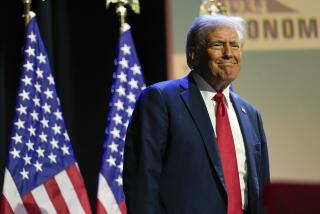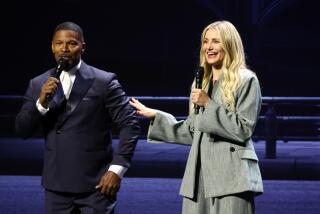Silly Season for IRAs--Incentives Are Bearish
- Share via
Folks opening individual retirement accounts at InterFirst Bank offices in Dallas and Houston have a tough decision to make before April 15.
The quandary, however, isn’t just what type of IRA to get. It’s also what freebie to take--the plush white bear with cap and scarf or the stuffed brown bear with the bow tie. The bank expects to give away 20,000 of them.
Meanwhile, at Empire Savings in Denver, IRA purchasers can now request the next year of their tax-deferred interest in American Eagle gold coins. And last year at Great Western Financial Corp., IRA depositors received $10-discounts on tax advice from H & R Block.
Welcome to the IRA silly season.
Over the years, customers have grown accustomed to receiving everything from posters to toasters for opening savings accounts at banks and savings and loans. Now, however, a smattering of institutions are starting to dangle such goodies to attract new IRA deposits. The estimated $75 million in IRA ads--in newspapers, on radio and on television--are just beginning to sprout like last year’s weeds.
But--thanks to tax reform regulations that severely limit IRA deductions starting in 1987--the ads are appearing earlier than ever. The wealthy, especially, will feel the pinch next year as most couples with incomes over $50,000 cannot qualify for IRA deductions. (Individuals not covered by company pensions will, however, be able to get full $2,000 deductions.)
“It’s topsy-turvy this year,” said Jim Dorsey, publisher of the IRA Reporter. “The smart people are advertising earlier and heavier.”
Indeed, somewhere around $40 million will be spent on new IRAs within the next four months, according to industry estimates.
With that in mind, some financial institutions have set up so-called IRA hot lines with toll-free phone numbers. Others began running IRA advertising as early as mid-summer.
One New York bank, Lincoln Savings Bank, ran ads in July that added drama to the situation. “The End is Near,” said the headline in its ad, referring to tax reform limits on IRAs.
Great Western Savings will spend more than $1 million on IRA ads this year. But while most banks will spend mega-bucks to tell customers the effects of tax reform on IRAs, Great Western won’t.
“We’ll let our competitors spend their money to educate,” said Neil Gargiulo, VP of marketing for Great Western.
“We’d prefer to tell customers why to choose ours.”
One thing is clear: “There is a lot of confusion out there,” said Frank Diekmann, managing editor of Bank Advertising News. “Whoever clears it up stands to make a bundle.”
First Lady Is Really Blunt
Until now, the wave of “Cocaine: The Big Lie” TV commercials have mostly featured real-life testimonials from former addicts and a few big-time sports figures. But in an effort to broaden the anti-drug campaign’s impact, the nonprofit trade group, the Advertising Council, has landed what its hopes will be its most effective spokesperson: Nancy Reagan.
In a new, 30-second spot distributed this week to more than 900 TV stations nationwide, the First Lady--who is seen in a close-up--puts it bluntly “There’s no more time to look the other way. Cocaine and crack kill.” The spot, which was created by DDB Needham Worldwide/New York, was taped in the White House. “We wanted a personality who would be able to talk to parents,” said Bill Rhatican, senior vice president at the Ad Council. “She filled the bill.”
Bigger Not Always Better
Sitting high above the storm of the ad world’s recent merger mania is one of the nation’s largest, yet still privately held ad firms, Leo Burnett Co.
“Others may feel differently and God bless ‘em,” said Hall Adams Jr., who, on Jan 1, will become chairman and chief executive of the parent agency from his current post as chief of the U.S. division. “But we don’t believe mega-mergers are in the best interest of our clients.” There are, however, less dramatic ways to grow. The agency--which gave birth to such famed offspring as Tony the Tiger and Morris the Cat--is looking at the possibility next year of acquiring some smaller agencies outside the United States, Adams said in a phone interview from Burnett’s Chicago headquarters.
Many other changes are in the works for the 51-year-old company, which expects to post 1986 billings of $2 billion. For one, it broke ground this year for a new headquarters building in downtown Chicago, scheduled for completion in early 1989. And previously announced shifts in top management include Adams’ replacing the retiring John Kinsella, and Richard Fizdale, 47, who will become president and replace the retiring Norman Muse.
But Adams said that none of these changes should affect such longtime clients as Kellogg Co. and Allstate Insurance Co., or newer clients such as Seven-Up Co. “We may be switching some people,” he said, “but not the way we do business with our clients.”
Turning Up Ad Voltage
A light flicked on at Eastman Kodak Co. this year that may forever change the battery industry. Suddenly, the film giant has begun to make batteries like Keebler makes cookies.
The surprise move has sent battery makers such as Ralston-Purina’s Eveready division and Duracell USA scrambling for new ad campaigns. And with good reason. Americans are so infatuated with battery-powered gizmos that they’ll buy about $2.5 billion worth of batteries this year--50% more then they purchased a decade ago, according to industry estimates.
Almost half of all domestic battery sales take place between Halloween and Christmas.
Most notably, Duracell took the offensive last month with an Ogilvy & Mather/NY-produced ad that asserted that its battery outlasts Kodak’s. Kodak responded by filing complaints with the TV networks, but it didn’t react to Duracell’s claims on the air--until late last week.
“Our intention is not to start an ad war,” said Chris Veronda, a Kodak spokesman, “but we’ve been challenged and we have to respond.”
In the new 30-second spot produced by J. Walter Thompson USA, Kodak asserts that its own tests show that Kodak Supralife gold-tipped batteries last as long--or longer--then Duracell’s Copper Top brand.
Kodak’s slogan: “Why go for the copper when you can go for the gold.”
Duracell, meanwhile, is uncertain how it will respond. “Comparative battery ads are a new phenomenon,” said John Bergman, communications vice president “We’ll have to think about it.”
More to Read
Inside the business of entertainment
The Wide Shot brings you news, analysis and insights on everything from streaming wars to production — and what it all means for the future.
You may occasionally receive promotional content from the Los Angeles Times.










